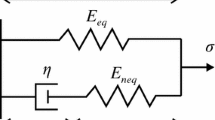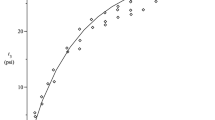Abstract
We give conditions on the strain–energy function of nonlinear anisotropic hyperelastic materials that ensure compatibility with the classical linear theories of anisotropic elasticity. We uncover the limitations associated with the volumetric–deviatoric separation of the strain–energy used, for example, in many Finite Element (FE) codes in that it does not fully represent the behavior of anisotropic materials in the linear regime. This limitation has important consequences. We show that, in the small deformation regime, a FE code based on the volumetric–deviatoric separation assumption predicts that a sphere made of a compressible anisotropic material deforms into another sphere under hydrostatic pressure loading, instead of the expected ellipsoid. For finite deformations, the commonly adopted assumption that fibres cannot support compression is incorrectly implemented in current FE codes and leads to the unphysical result that under hydrostatic tension a sphere of compressible anisotropic material deforms into a larger sphere.




Similar content being viewed by others
References
Musgrave MJP (1970) Crystal acoustics. Holden-Day, San Francisco
Destrade M, Martin PA, Ting TCT (2002) The incompressible limit in linear anisotropic elasticity, with applications to surface waves and elastostatics. J Mech Phys Solids 50:1453–1468
Royer D, Dieulesaint E (1984) Rayleigh wave velocity and displacement in orthorhombic, tetragonal, hexagonal, and cubic crystals. J Acoust Soc Am 76:1438–1444
Merodio J, Ogden RW (2003) Instabilities and loss of ellipticity in fiber-reinforced compressible non-linearly elastic solids under plane deformation. Int J Solids Struct 40:4707–4727
Holzapfel GA, Gasser TC, Ogden RW (2000) A new constitutive framework for arterial wall mechanics and a comparative study of material models. J Elast 61:1–48
Spencer AJM (1972) Deformations of fibre-reinforced materials. University Press, Oxford
Ogden RW (1978) Nearly isochoric elastic deformations: application to rubberlike solids. J Mech Phys Solids 26:37–57
ABAQUS/standard user’s manual, Ver. 6.10 (2010) Dassault Systèmes Simulia Corporation, Pawtucket
ANSYS 14.0 training manual-fluent (2011) ANSYS, Inc., Canonsburg
FEBio theory manual, Ver. 1.5 (2012). http://mrl.sci.utah.edu. Accessed 15 May 2013
ADINA theory and modeling guide (2005). ADINA R &D, Inc., Watertown
Federico S (2010) Volumetric-distortional decomposition of deformation and elasticity tensor. Math Mech Solids 15:672–690.
Merodio J, Ogden RW (2006) The influence of the invariant \(I_8\) on the stress-deformation and ellipticity characteristics of doubly fiber-reinforced non-linearly elastic solids. Int J Non-Linear Mech 41:556–563
Royer D, Dieulesaint E (2000) Elastic waves in solids I. Free and guided propagation. Springer, Berlin
Gasser TC, Ogden RW, Holzapfel GA (2006) Hyperelastic modelling of arterial layers with distributed collagen fibre orientations. J R Soc Interface 3:15–35
Ní Annaidh A, Destrade M, Gilchrist MD, Murphy JG (in press) Deficiencies in numerical models of anisotropic nonlinearly elastic materials. Biomech Model Mechanobiol. doi:10.1007/s10237-012-0442-3.
Sansour C (2008) On the physical assumptions underlying the volumetric–isochoric split and the case of anisotropy. Eur J Mech A 27:28–39
Acknowledgments
This work was supported by the Royal Society through an International Joint Project awarded to the second and fourth authors. Finally, the authors are grateful to Jerry Murphy (Dublin City University) for stimulating discussions on the topic. The work of the second author was also partially supported by a ‘Government of Ireland New Foundations Award’ received from the Irish Research Council.
Author information
Authors and Affiliations
Corresponding author
Appendix A: monoclinic elasticity
Appendix A: monoclinic elasticity
Here we extend the results of Sects. 2 and 3 to the case of monoclinic symmetry, for which, in the linear theory, there are 13 independent elastic constants. For this purpose it suffices to consider an isotropic matrix material reinforced with two families of fibres, with fibre directions defined by \(\varvec{M}\) and \(\varvec{M}^{\prime }\) in the reference configuration, the fibres being in general neither at right angles nor mechanically equivalent. First we establish the general equations of compatibility between nonlinear and linear anisotropic elasticity.
With two fibre directions, the strain–energy function \(W\) is a function of three isotropic strain invariants (\(I_1,\,I_2,\,I_3\)) and five anisotropic invariants (\(I_4,\,I_5,\,I_6,\,I_7,\,I_8).\) Thus,
where
Note that, to simplify the ensuing analysis, we are using the invariant \(I_8\) as defined above, rather than one of its strictly invariant forms \(I_8\varvec{M}\cdot \varvec{M}^{\prime }\) or \(I_8^2,\) which do not depend on the sense of either \(\varvec{M}\) or \(\varvec{M}^{\prime }.\)
For the expression for the Cauchy stress \(\varvec{\sigma }\) in the incompressible case we refer to Merodio and Ogden [13]. Here we use its compressible counterpart
In the reference configuration the invariants take the values
Assuming that the reference configuration is stress free, it follows from (57), when evaluated in the reference configuration, that the conditions
must hold there.
Now let \(\mathbf e \) be the infinitesimal strain tensor and let \(e=\text{ tr }\mathbf e .\) Then, to the first order in \(\mathbf e ,\) we obtain
and \(\mathbf B =\mathbf I +2\mathbf e .\) Then, using the restrictions (59) and linearizing (57) in \(\mathbf e ,\) we obtain, after a lengthy but straightforward process,
where we have introduced the notations
for the combinations of derivatives of \(W\) evaluated in the reference configuration. These constants, together with \(W_5,\,W_7\) and \(W_{88}\) constitute the 13 independent elastic constants of monoclinic symmetry.
By comparing with the general expression for the Cauchy stress in linear anisotropic elasticity in terms of the Voigt notation we obtain 21 expressions for elastic constants, only 13 of which are independent. These are summarized as
for \(i,\,j\in \{1,\,2,\,3\},\,i\ne j,\)
Note, in particular, that \(W_5\) and \(W_7\) do not appear in \(c_{14}.\) This is because the index 4 corresponds to the pair of indices 23, which are different from the first index 1 in this case. The constants \(c_{24},\,c_{25},\,c_{26}\) and \(c_{34},\,c_{35},\,c_{36}\) follow the same pattern, with the index 1 in the bracketed terms replaced by 2 and 3, respectively. Then, \(c_{25}\) and \(c_{36}\) do not contain \(W_5\) and \(W_7.\)
We also have
Then, \(c_{55}\) and \(c_{66}\) are obtained by replacing the index 2 by 1 and the index 3 by 1, respectively.
Finally, we have
and \(c_{46}\) and \(c_{56}\) are obtained simply by re-ordering the indices appropriately.
It is now convenient to let the two fibre directions in the reference configuration define the \((x_1,\,x_2)\) coordinate plane, so that \(M_3=M_3^{\prime }=0\) and the 21 constants reduce to the 13 appropriate for monoclinic symmetry, with \(c_{14}=c_{24}=c_{34}=c_{15}=c_{25}=c_{35}=c_{46}=c_{56}=0.\)
We now turn to the formulation of the strain–energy function based on the invariants \(I^*_1,\,I^*_2,\,I_3,\,I^*_4,\,I^*_5,\,I^*_6,\,I^*_7\) defined in Sect. 3, supplemented by their counterpart for \(I_8,\) namely
Thus, \(W^*=W^*(I^*_1,\,I^*_2,\,I_3,\,I^*_4,\,I^*_5,\,I^*_6,\,I^*_7,\,I^*_8)\) and it is easy to show that the conditions (59) holding in the reference configuration become
It also follows that
and
while the terms in (61) that do not involve a derivative with respect to \(I_3\) are unaffected by the change \(W\rightarrow W^*.\) Note that \(W^*_{13}\) and \(W^*_{23}\) do not appear.
The terms in (71) can now be simply related to the Voigt constants. Specifically, we obtain
For a decoupled model of the form
it follows that \(W^*_{34}=W^*_{35}=W^*_{36}=W^*_{37}=W^*_{38}=0\) and hence the Voigt constants must be interrelated according to
and the 13 constants are reduced to 10. Thus the material is not fully monoclinic in the linearized limit. It follows that materials with two families of non-orthogonal fibres for which the strain–energy function can be decomposed additively as (76) do not behave like monoclinic solids when subject to infinitesimal deformations. It can also be checked that a monoclinic material for which the restrictions (77) hold deforms in pure dilatation under hydrostatic stress.
By switching the indices 1 and 3 in the first two results in (77) the results (25) in Sect. 3 are recovered (here \(\varvec{M}\) and \(\varvec{M}^{\prime }\) define the \((x_1,\,x_2)\) plane whereas in Sect. 3 they define the \((x_2,\,x_3)\) plane).
Rights and permissions
About this article
Cite this article
Vergori, L., Destrade, M., McGarry, P. et al. On anisotropic elasticity and questions concerning its Finite Element implementation. Comput Mech 52, 1185–1197 (2013). https://doi.org/10.1007/s00466-013-0871-6
Received:
Accepted:
Published:
Issue Date:
DOI: https://doi.org/10.1007/s00466-013-0871-6




